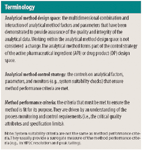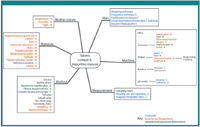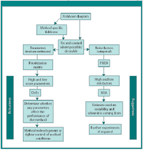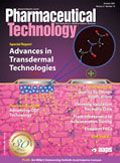The Application of Quality by Design to Analytical Methods
To monitor and control processes or products, analytical methodology must be fit for purpose. An approach to apply quality by design principles to the design and evaluation of analytical methods has therefore been developed to meet these needs. This article features a downloadable template on which to conduct a failure mode effect analysis (FMEA).
During the past few years, regulatory agencies have placed an increased emphasis on pharmaceutical process understanding. The US Food and Drug Administration's Pharmaceutical CGMPs for the 21st Century-A Risk Based Approach describes how combining a focus on process understanding with a structured risk-assessment process can help develop control strategies that enhance process robustness (1). Similar concepts are also discussed in ICH Q8 Pharmaceutical Development and International Conference on Harmonisation (ICH) Q9 Quality Risk Management (2, 3). Collectively, these principles are described as "quality by design" (QbD). As defined by Janet Woodcock in 2004, "QbD means that product and process performance characteristics are scientifically designed to meet specific objectives, not merely empirically derived from performance of test batches." This article describes how the principles of QbD being developed for manufacturing processes can equally well be applied to ensure that analytical tests methods and process analytical technology (PAT) are robust, as defined by ICH Q2(R1), and rugged, as defined by the United States Pharmacopeia (USP) (4, 5).
Analytical method robustness testing typically involves evaluating the influence of small changes in the operating conditions. Ruggedness testing identifies the degree of reproducibility of test results obtained by the analysis of the same sample under various normal test conditions such as different laboratories, analysts, and instruments. The term robustness has been used differently when describing chemical processes and includes factors deemed as robustness parameters and ruggedness factors in the analytical world. Processes, for example, have been defined as robust if they have the ability to tolerate the expected variability of raw materials, operating conditions, process equipment, environmental conditions, and human factors (6).

Terminology
The examples in this article are based on chromatographic and PAT methods to support new-product development. Nonetheless, the concepts can be applied to any method type and can be used to improve the reliability of established methods. As the principles described in this article bring fundamental method understanding, the adoption of this approach will reduce manufacturing resources involved with investigating out-of-specification results as well as increase the confidence in analysis testing cycle times. They also lay the foundations for less regulatory oversight of method changes, which should facilitate innovation and continuous improvement.
Processes must meet current good manufacturing practices to ensure drug products meet safety and efficacy requirements (7). Traditionally, this requirement has been met by performing process validation studies on three batches. It has been recognized that this approach is unlikely to fully represent routine manufacture and unlikely to cover all potential sources of variability (e.g., raw materials, operators, shifts, reactor vessels). Moheb Nasr, director of the Office of New Drug Quality Assessment at FDA, has identified this issue as a challenge to the regulatory process and has stated that there is currently a "focus on process validation and not process understanding" (8).
In a similar way, the traditional approach to analytical method validation described in ICH Q2(R1) and analytical method transfer represents a one-off evaluation of the method and does not provide a high level of assurance of method reliability. The limited understanding of a method obtained through these traditional approaches has often led to it passing the technology transfer exercise (by chance) from development into use in commercial manufacturing facilities. In reality a significant method variable had not been fully explored, thereby leading to method failure some months post-transfer. Even when transfers have failed (the more desirable scenario if the method is poor, enabling issues to be identified), significant resources are often required to attempt to remedy the causes of the transfer failure, usually at a time when there is considerable pressure to support the introduction and launch of a new product. Both of these scenarios are undesirable and would be recognized in many pharmaceutical analysis laboratories as significant issues.
Current approaches to analytical technology transfer—in which, for example, three batches have been analyzed each in duplicate at the transferring and receiving sites—represent a one-off exercise aimed at proving that a receiving laboratory can operate the analytical method (9–12). These approaches really only confirm that the analyst, equipment, and other components involved in the exercise can operate the method at the time of the transfer exercise. The desired state is proving that the method will be reliable (robust and rugged) throughout the life cycle of its use. Instead of the generic technology-transfer exercise, it is more appropriate that a risk assessment be performed to identify potential variables and that this should dictate which robustness and ruggedness experiments are performed. The latter can be tested as part of a measurement systems analysis study in which the most likely sources of variability are identified and studied. All the knowledge (not just the technology) should then be transferred; any future changes to the method or the environment in which it is operated should be risk assessed; and, if appropriate, equivalency should be demonstrated as part of an overriding change-control procedure.
The current reality is that the pharmaceutical industry has 6-sigma products on the market but only 2.5 sigma processes (13). The capability of many analytical methods and controls used to monitor these processes is nearly as poor. Nevalainen et al., for example, have estimated analytical performance at the 3.85-sigma level (14). To move pharmaceutical processes and analytical methodology toward much improved sigma capability, an objective, cross-functional, data-driven assessment of all the steps within a process or method must be performed.
A framework for applying QbD to analytical methods
Figure 1 illustrates the high-level components of how QbD can be applied equally to processes and analytical methods. It displays how QbD for analytical methods is driven by the overall process-control strategy.

Figure 1: The high-level components of how quality by design can be applied to processes and analytical methods.
Method performance requirements (design intent). Fundamental to any method development is being clear about the design intent of the method (i.e., the criteria that must be met). Method-performance criteria and method-operational intent are two important aspects of this design intent.
Method-performance criteria. These criteria are driven by an understanding of the process monitoring and control requirements; that is, the process critical quality attributes (CQAs) and specification limits. CQAs are identified, through a thorough understanding of those characteristics of a drug substance or a drug product that may need to be controlled to ensure the safety or efficacy of a product. For methods measuring these CQAs, criteria, such as the following, would need to be met:
- Precision—the need for method variability to be a small proportion of the specification
- Selectivity—being clear on which impurities actually need to be monitored at each step in a process and ensuring adequate discrimination between them
- Sensitivity—ensuring the method is sufficiently sensitive relative to the specification limit.
PAT methods often meet the criteria above in a different way from traditional end-point testing methods such as high-performance liquid chromatography (HPLC). Selectivity, for example, may be achieved through a multivariate model as opposed to resolution between adjacent peaks in an HPLC method. For these methods, precision could be demonstrated by checking the prediction validity of the model.
Method operational intent. These criteria address the aspects of the method that are required to facilitate ease of use in routine operation (e.g., analysis time, acceptable solvents , available equipment). Opportunities for the implementation of improved or new technology also may be identified. These criteria can be generated by performing an analysis of the voice of the customer (VoC) (i.e., the aspects of a method that are considered important for the quality control laboratories within manufacturing where the commercial methods will be operated).
Method development (design selection). Fundamental to design selection is the method-development phase. To develop a QbD method, the method performance criteria must be understood as well as the desired operational intent that the eventual end user would wish to see in the method. To deliver the latter, methods must take into account the VoC.
The method development process should use an agreed standardized approach between development and manufacturing. For example, within GSK there is a companywide strategy for chromatographic methods that is based on the best scientific knowledge and expertise that is aimed at minimizing unnecessary and detrimental diversity. The design of the method is a key decision. Issues that may easily be solved by appropriate selection at this point are likely to be more difficult to fix later, if trying to optimize a poor method not suited to meet its method-performance criteria. Consideration also must be given to whether on-line methods can be used in place of traditional lab-based methods. This assessment takes place once the CQAs for the process have been identified.
Through a thorough understanding of the design intent, methods for commercial operation would be designed only for those specific impurities relevant to the commercial product. Historically, the methods transferred into quality control laboratories have often taken into account potential impurities detected in earlier routes of synthesis, which cannot be formed from the commercial route or monitor theoretical degradation products that, in practice, are not formed during routine stability studies. Significant opportunities exist to identify what is truly critical to control and reduce method complexity once sufficient process understanding is obtained.
Risk assessment and analytical design-space definition (control definition). It is imperative to reach a high degree of confidence that the analytical method will meet all method performance criteria under all conditions of use as it progresses through the lifecycle. This confidence level can be achieved by using a rigorous approach for identifying all the potential method factors that may need to be controlled to ensure method performance and through the use of risk assessment tools and prioritized experimentation that eliminate areas of risk.
To maximize the benefits of performing a risk assessment, the analysts who have developed the method should work as a team with the analysts who will be using the method in manufacturing. To fully understand the method, a walk-through is recommended that involves all the analysts observing one analyst using the method from start to finish in the manufacturing environment. Each of the steps within the method can then be mapped out separately (e.g., sample preparation, dissolution, extraction, chromatographic separation, data analysis).
A cause-and-effect diagram, also known as a fishbone or Ishikawa diagram, can then be used after the walk through to facilitate brainstorming of all the potential factors that may influence the method performance criteria (15). Mind-mapping software can be valuable in this exercise because it facilitates the collection of all the detailed factors that represent potential variables in the method. Figure 2 shows an example of part of a fishbone performed on a tablet HPLC assay–impurities method. Under each subheading, there are further factors (not shown in Figure 2). For example, for HPLC, subfactors include the pump, dwell volume, autosampler, and detector. With information obtained from operating the method and the walk-through, analysts are encouraged to draw upon their past experience of the operation of similar methods on various products to ensure that previous lesssons learned are incorporated into the risk assessment. Establishing a corporate knowledge repository for important factors for each technique can facilitate this learning process.

Figure 2: Fishbone diagram created for an HPLC assay and impurities method.
Risk assessment tools such as a priority matrix and failure mode effect analysis (FMEA) (16–18) can be used to identify where variability in a factor or failure of part of the system might represent a risk to the method's ability to deliver the design intent. Before any experimentation is performed, the method must be improved where possible by using the output from the FMEA. As many high-risk factors as possible are controlled or fixed to eliminate the potential sources of variability. Table I shows an example of part of an FMEA for a PAT near infrared (NIR) method used for drying monitoring. An additional column entitled "Action" is not shown in Table I. This column is used to lower or mitigate the risk identified for the failure modes that have been identified.

Table I: FMEA for a PAT NIR method used for drying monitoring.Click here to download a template on which to conduct a failure mode effect analysis (FMEA).|~www.pharmtech.com/pharmtech/Online+Exclusive/Sustainable-Packaging-Resources/ArticleStandard/Article/detail/464686
Click here to download a template on which to conduct a failure mode effect analysis (FMEA).
A tool known as CNX can help classify all the factors in the fishbone diagram. The team decides which factors should be controlled (C), which are potential noise factors (N), and which should be experimented on (X) to determine acceptable ranges. The factors have been categorized using CNX in Figure 2.
Robustness studies are performed for the highest risk parameters for which acceptable ranges will need to be identified (X-type factors). Design of experiments (DOE) is used to assess the multidimensional combination and interaction effects of these factors. For the highest risk noise (N-type factors), a ruggedness study is performed using a measurement systems analysis (MSA) design. This study aims to challenge the method, giving as much opportunity as possible for any problems to surface.
Once the method has been evaluated by DOE and MSA and improved as necessary, the FMEA can be used once again to assess the risk attached to operating the method and establish the proven acceptable ranges for the method factors. The output of the statistical studies is documented as the analytical method design space. Figure 3 provides an overview of the whole risk-assessment process.

Figure 3: Flow chart overview of a risk assessment process.
Analytical method control strategy (control verification). Using the appropriate risk-assessment tools, the critical factors and their acceptable ranges (from the risk assessment or experimental work) are explicitly defined in the method. Throughout a method's life cycle, which often stretches over many years, it is inevitable that there will be changes in the method environment that can affect its operation. Changes and improvements to a method should be made with reference to the method knowledge repository, which contains all the information from design space definition activities. This repository should contain the risk-assessment information and results from method ruggedness and robustness studies.
Any proposed changes that take the method outside its proven design space are risk assessed. For high-risk changes, an evaluation or equivalence exercise should be performed to ensure method performance criteria are still met. Method-specific lesssons learned are used to update the method knowledge repository. Technique lesssons learned are used to enhance the risk-assessment process for future methods.
Opportunities of and barriers against a QbD approach to analytical methods
There are several opportunities of this QbD approach to analytical methods, including:
- Methods will be more robust and rugged, resulting in fewer resources spent investigating out-of-specification results and greater confidence in analysis testing cycle times
- Resources currently invested in performing traditional technology transfer and method validation activities will be redirected to ensuring methods are truly robust and rugged
- The introduction of new analytical methods—from research and development to quality control laboratories—using a QbD approach will lead to a higher transfer success rate than with traditional technology-transfer approaches
- A specified process will help the systematic and successful implementation of the QbD methodology and fosters a team approach
- A true continuous learning process is established through the use of a central corporate knowledge repository that can be applied across all methods
- By registering only a commitment to ensure method changes meet the registered method performance criteria, flexibility to continuously improve methods can be achieved.
The QbD approach to analytical methods also faces several barriers, including the following:
- Current expectations of analytical technology transfer and method validation must change because current validation guidance does not lead to methods that can always be reliably operated
- Acceptance must be gained for registration of the method performance criteria rather than the method conditions
- External guidance must be developed in this area; ICH guideline Q2(R1) requires revision (or removal) and Center for Drug Evaluation and Research guidance must be created for analytical methods
- A common language for some of the new terms is required, including analytical method design space, analytical method control strategy, and method performance criteria
- Analysts must learn new tools and skills
- A consistent worldwide approach is required for this initiative to be effective.
Conclusion
The goal of a well-characterized method development effort is to develop a reliable method that can be demonstrated with a high degree of assurance to consistently produce data meeting predefined criteria when operated within defined boundaries. The process detailed in this article illustrates how QbD can be applied to the development and evaluation of analytical methods.
During method development, all potential factors (the inputs) and all critical analytical responses (the outputs) are studied to determine the relationships. Critical analytical factors are identified in an approach that parallels what is described for process development in ICH Q8 and Q9. The QbD process outlined in this article relies on an active partnership of analytical scientists at both the development and operational laboratories as methods are developed and as factors that lead to potential method failures are identified and controlled. A corporate knowledge repository is required throughout the process to ensure critical information is captured that can be reviewed and added to in the future such that lesssons learned can be applied to the specific method under consideration and also to other similar methods being applied to other products. Such a repository (in line with concepts described in the draft ICH Q10) will enable continuous improvement and change control of the method to take place throughout its lifecycle.
Rather than continuing to perform analytical technology transfer exercises and ICH validation, a QbD approach based on a risk-assessed change control procedure should be adopted. Each time a method is changed, a risk assessment should be performed. Where the change is identified as having a potential to take the method outside its known design space, a method evaluation and, if appropriate, an equivalency exercise should be performed to ensure method performance criteria are still met. This will allow for method improvements to be made via internal change control procedures, and even switches between different techniques (e.g., HPLC versus NIR) may become much easier to implement.
A QbD approach for analytical methods that includes risk assessment, robustness testing, and ruggedness testing is much more rigorous than ICH validation requirements (Q2(R1)). It also includes an assessment of method variability compared with the specification limits, which is one of the most important method attributes to test when deciding whether the method is fit for its purpose. The approach described herein suggests that ICH Q2(R1), while adding some value, must be substantially rewritten to take account of the QbD risk-based approaches described in this article.
This new QbD process offers the opportunity for much greater regulatory flexibility in the future. The method performance criteria could potentially be registered instead of the method itself. The method used could be referred to as an example of how to attain the required method performance criteria. Any changes to this method would be covered by internal change control procedures.
Phil Borman,* is a manager in Strategic Technologies, Chemical Development, at GlaxoSmithKline, Gunnels Wood Road, Stevenage, Hertfordshire SG1 2NY UK, tel. 44 1438 763713, fax 44 1438 764414, phil.j.borman@gsk.comMarion Chatfield is a manager in Statistical Sciences at GlaxoSmithKline (Hertfordshire). Phil Nethercote is a director in New Product Support, Global Manufacturing Supply at GlaxoSmithKline (Ayrshire, UK). Duncan Thompson is a senior process analyst in Strategic Technologies, Chemical Development at GlaxoSmithKline (Hertfordshire). Keith Truman is vice-president of the Scientific Information Centre of Excellence, Pharmaceutical Development, at GlaxoSmithKline (Hertfordshire).
*To whom all correspondence should be addressed.
Submitted: June 21, 2007. Accepted: Aug. 2, 2007.
References
1. US Food and Drug Administration, Pharmaceutical CGMPs for the 21st Century—A Risk Based Approach, 2004.
2. The International Conference on Harmonisation of Technical Requirements for Registration of Pharmaceuticals for Human Use, Quality Guideline Q8 Pharmaceutical Development, 2006.
3. The International Conference on Harmonisation of Technical Requirements for Registration of Pharmaceuticals for Human Use, Quality Guideline Q9 Quality Risk Management, 2006.
4. The International Conference on Harmonisation of Technical Requirements for Registration of Pharmaceuticals for Human Use, Quality Guideline Q2(R1) Validation of Analytical Procedures: Text and Methodology, 2005)
5. USP 29–NF 24 (United States Pharmacopoeial Convention, 2006), Chapter ‹1225›.
6. M. Glodek et al., "Process Robustness —A PQRI White Paper," Pharm. Eng. 26 (6), 1–11 (Nov.–Dec. 2006).
7. FDA 21 CFR Title Parts 210– 226 (2006).
8. M. Nasr, "FDA Perspective on the Implementation of Quality by Design," paper presented at the Ninth APIC/CEFIC (Prague, Czech Republic, Oct. 2006).
9. M. Swartz and I. Krull, "Analytical Method Transfer," LC-GC 24 (11), 20–24, (2006).
10. ISPE Good Practice Guide: Technology Transfer (ISPE, Tampa, Florida, 2003).
11. S. Scypinski et al., "Analytical Method Transfer," Pharm. Technol. 26 (3), 84–88 (2002)
12. PhRMA Analytical Research and Development Workshop, Wilmington, Delaware, Sept. 20, 2000.
13. "The Metamorphosis of Manufacturing," IBM report, Apr. 2005.
14. D. Nevalainen et al., "Evaluating Laboratory Performance on Quality Indicators with the Six Sigma Scale," Arch. Pathol. Lab. Med. 124, 516–519 (2000).
15. K. Ishikawa, What is Total Quality Control? The Japanese Way (Prentice-Hall, Englewood Cliffs, NJ, 1985), 63–64.
16. D. Stamatis, Failure Modes and Effects Analysis, FMEA from Theory to Execution (ASQ Qualtiy Press, Milwaukee, WI, 2d ed., 2003).
17. R. McDermott, R. Mikulak, and M. Beauregard, The Basics of FMEA (Quality Resources, New York, 1996).
18. Dyadem Press, "Guidelines for Failure Modes and Effects Analysis (FMEA) for Medical Devices," 2003.
